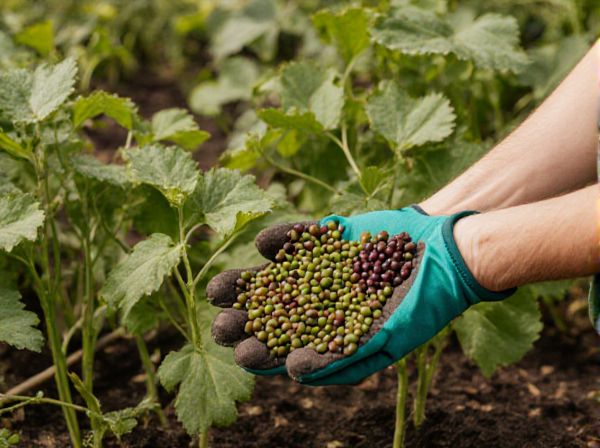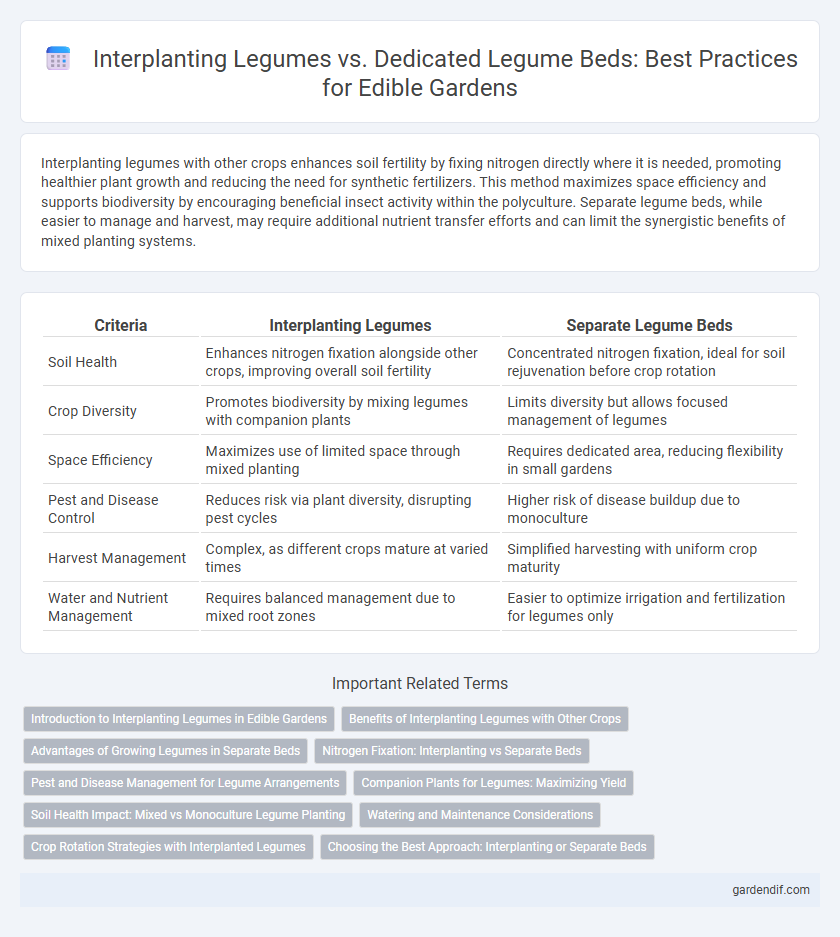
Interplanting legumes vs separate legume beds Illustration
Interplanting legumes with other crops enhances soil fertility by fixing nitrogen directly where it is needed, promoting healthier plant growth and reducing the need for synthetic fertilizers. This method maximizes space efficiency and supports biodiversity by encouraging beneficial insect activity within the polyculture. Separate legume beds, while easier to manage and harvest, may require additional nutrient transfer efforts and can limit the synergistic benefits of mixed planting systems.
Table of Comparison
| Criteria | Interplanting Legumes | Separate Legume Beds |
|---|---|---|
| Soil Health | Enhances nitrogen fixation alongside other crops, improving overall soil fertility | Concentrated nitrogen fixation, ideal for soil rejuvenation before crop rotation |
| Crop Diversity | Promotes biodiversity by mixing legumes with companion plants | Limits diversity but allows focused management of legumes |
| Space Efficiency | Maximizes use of limited space through mixed planting | Requires dedicated area, reducing flexibility in small gardens |
| Pest and Disease Control | Reduces risk via plant diversity, disrupting pest cycles | Higher risk of disease buildup due to monoculture |
| Harvest Management | Complex, as different crops mature at varied times | Simplified harvesting with uniform crop maturity |
| Water and Nutrient Management | Requires balanced management due to mixed root zones | Easier to optimize irrigation and fertilization for legumes only |
Introduction to Interplanting Legumes in Edible Gardens
Interplanting legumes in edible gardens enhances soil fertility by naturally fixing nitrogen, promoting healthier plant growth and increased yield. This method maximizes space efficiency and biodiversity compared to separate legume beds, allowing companion plants to benefit from nutrient sharing and pest reduction. Incorporating legumes such as peas, beans, or lentils between vegetable crops creates a sustainable ecosystem that supports long-term garden productivity.
Benefits of Interplanting Legumes with Other Crops
Interplanting legumes with other crops enhances soil fertility by fixing atmospheric nitrogen directly where companion plants can absorb it, reducing the need for synthetic fertilizers. This practice improves biodiversity and pest management by attracting beneficial insects and disrupting pest life cycles, resulting in healthier crop growth. Crop yields benefit from improved soil structure and nutrient availability, making interplanting legumes an effective approach for sustainable and productive edible gardens.
Advantages of Growing Legumes in Separate Beds
Growing legumes in separate beds enhances soil nitrogen fixation by concentrating root nodules in a dedicated area, improving nutrient availability for future crops. This method allows for better pest and disease management by isolating legume-specific issues from other plants, reducing cross-contamination risks. Additionally, separate beds simplify crop rotation and targeted fertilization strategies, optimizing legume growth and overall garden productivity.
Nitrogen Fixation: Interplanting vs Separate Beds
Interplanting legumes with other crops enhances nitrogen fixation efficiency by allowing simultaneous nutrient exchange within shared root zones, promoting soil fertility. Separate legume beds isolate nitrogen fixation benefits, which may delay nutrient availability for adjacent crops but simplify management and prevent competition. Optimizing nitrogen fixation depends on crop choice, spatial arrangement, and soil conditions, with interplanting often improving overall system productivity and sustainability.
Pest and Disease Management for Legume Arrangements
Interplanting legumes with other crops enhances pest and disease management by promoting biodiversity, which disrupts pest cycles and reduces the spread of legume-specific pathogens. Separate legume beds can concentrate pests and diseases, increasing the risk of outbreaks and requiring more intensive intervention. Integrating legumes within diverse plantings leverages natural pest suppression and minimizes reliance on chemical controls, improving overall crop health and sustainability.
Companion Plants for Legumes: Maximizing Yield
Interplanting legumes with companion plants such as corn, squash, or cucumbers enhances nitrogen fixation and optimizes soil nutrients for increased yield. Companion plants improve pest control and reduce disease risk by promoting biodiversity, leading to healthier legume crops. Separate legume beds may simplify crop management but often miss the synergistic benefits of intercropping systems.
Soil Health Impact: Mixed vs Monoculture Legume Planting
Interplanting legumes with other crops enhances soil health by promoting nitrogen fixation and increasing microbial biodiversity, leading to improved nutrient cycling and soil structure. In contrast, separate legume beds often result in monoculture conditions that may limit biodiversity and reduce overall soil resilience. Mixed planting systems support sustainable soil fertility and reduce the risk of soil-borne diseases compared to monoculture legume cultivation.
Watering and Maintenance Considerations
Interplanting legumes with other crops can optimize water usage by allowing shared irrigation systems, reducing overall water consumption compared to separate legume beds. Separate legume beds require dedicated watering schedules to meet their specific moisture needs, which can increase labor and maintenance efforts. Interplanted legumes also benefit from mutual pest resistance and nutrient cycling, leading to less frequent maintenance interventions.
Crop Rotation Strategies with Interplanted Legumes
Interplanting legumes within crop rotation strategies enhances soil nitrogen levels through natural fixation, reducing the need for synthetic fertilizers. This method promotes biodiversity and disrupts pest cycles more effectively than separate legume beds by integrating nitrogen-fixing plants directly with other crops. Crop rotation plans incorporating interplanted legumes improve overall soil structure and nutrient balance, leading to higher crop yields and sustainable farm productivity.
Choosing the Best Approach: Interplanting or Separate Beds
Interplanting legumes enriches soil nitrogen directly within vegetable rows, improving nutrient availability and maximizing space use in edible gardens. Separate legume beds allow better control over plant growth and pest management, facilitating targeted care and easier harvesting. The decision depends on garden size, crop compatibility, and desired maintenance intensity for optimal edible yield.
Interplanting legumes vs separate legume beds Infographic

 gardendif.com
gardendif.com